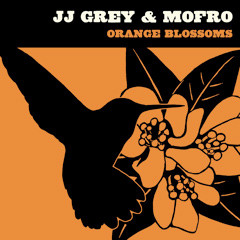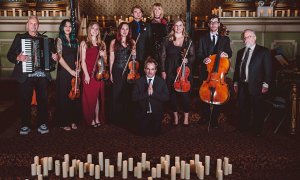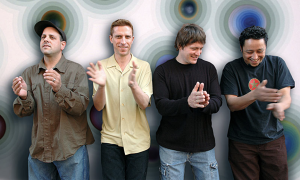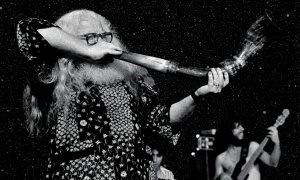Home » Jazz Articles » From the Inside Out » Exploring More Exploratory Ensembles
Exploring More Exploratory Ensembles
 The Paul Carlon Octet
The Paul Carlon Octet
Roots Propaganda
Deep Tone
2008
"I am interested in combining all roots music," explains saxophonist, bandleader, composer, and educator Paul Carlon. "Not necessarily to make a point, but because I love it all. So I'm trying to take these disparate elements and put them into a jazz context." Carlon continues, "That was the idea behind Roots Propaganda. We need some propaganda for this kind of music."
"This kind of music" boasts a uniquely powerful and genuine Afro-Cuban spirit thanks to its percussive rhythms, twin trombone engine blasts (from Ryan Keberle and Mike Fahie), and marvelously complementary vocal accents from the exotic Christelle Durandy, born in France to parents from Guadalupe and Madagascar.
Recorded and mixed in New York City and Sao Paulo, Roots Propaganda is ambitious in concept and execution. The primal "Ochun" starts on the ground floor, solitary saxophone singing its traditional melody then introducing a tribal vocal chant with accompanying flute and percussion. The dynamic opener "Backstory" lifts you several floors higher, as its percussion and horn charts dance together in lusty Latin rhythm. Though it ebbs and flows, "The Most Beautiful Thing" is constantly energized by the crackling rhythms from drummer William "Beaver" Bausch and percussionist Max Pollak.
Carlon's "The Limiter" caps the summit: An acoustic piano trio sketches the opening, then drummer Bausch shifts into a steady rocking four as pianist John Stenger dashes from corner to corner to fill out the sketch, calling in horns and other instruments to nurture a full Latin jazz orchestra which blossoms from its opening sketch.
Carlon even simmers two blues into his meaty Afro-Cuban stew. The trombone brightly leads an instrumental cakewalk through "Nobody Knows You When You're Down and Out" that burns with true Afro-Cuban spirit, with music that's sometimes a little wobbly and blue but always full of energy and promise too. As the title track dies down, its embers erupt with fiery tongues of Latin brass into the "Hard Times Killin' Floor Blues," an exquisite genre-melting segue that genuinely captures the authentic Latin, jazz, and Latin jazz spirits of Carlon's Roots Propaganda muse.
"I don't want to beat people over the head with being deep," Carlon admits. "I want to have a good time, and I want the audience to have a good time whether they catch all the details or not."

Serve or Suffer
Half Note
2008
This all-star jazz-meets-R&B project, recorded live at the Blue Note in August '07 is orchestrated by vocalist Roseanna Vitro and pianist Kenny Werner who contributes several head-spinning arrangements of familiar blues, rhythm and blues, and not-quite-blues. The album certainly gets an "A" for effort. "I found the writing process fascinating. Some of the tunes were very familiar in their original recorded versions, but I still wanted to give them a new spin," enthuses Werner. "That required me to honor the essence of what made them work the first time around—whether they were funky or nasty or rockin."
Werner's opening rearrangement of the '70s R&B classic "What is Hip?" comes blasting out like a cannonball and smartly retains most of the original Tower of Power horn chart, which maximizes the considerable punch of the Delirium all-star horns: Ray Anderson (trombone), Randy Brecker (trumpet), James Carter (tenor sax) and Geoff Countryman (baritone sax, bass clarinet). "Cheater Man" similarly plays rough and tumble but with the big-band R&B meets blues sound of Roomful of Blues, especially when the horns play cat-and-mouse with Rocky Bryant's whippersnap snare in the bridge.
Joni Mitchell's "Be Cool" fits Vitro's voice and delivery best, with Werner's arrangement wafting comfortably in Mitchell's ethereal and floating jazz-pop fusion, bobbing like a balloon after air punches from its horn chart. Werner's take on "Blue," co-written by Jon Hendricks, echoes the classic "big band with vocalist" sound: Overlaying horns harmonize the introduction, then step aside for Vitro's dance with Werner's acoustic piano to time softly kept by brushes; Vitro steps aside in turn for James Carter's well-trimmed alto solo.
Arranged to a rousing blend of classic blues styles—the chugging locomotive of electric Chicago blues lugging a boxcar bursting with New Orleans brass—"Don't Ever Let Nobody Drag Your Spirit Down" proves the perfect closer. Vitro tugs and pulls with all her might though she sometimes seems a bit overmatched if not by Werner's arrangements then by the material (Lil Green's "In the Dark," for example). Even so, Werner and guitarist Adam Rogers rip off electric blues solos almost as torrid as the call and response between Brecker and Anderson, who proceeds to blow out all the windows with his trombone solo rampage.
 JJ Grey & Mofro
JJ Grey & Mofro
Orange Blossoms
Alligator
2008
JJ Grey and Mofro's follow-up to their critically and popularly acclaimed 2007 Alligator debut, Country Ghetto, sounds a little less shocking but no less rocking. It feels as if that first release, in retrospect, was a shout designed by songwriter, producer, singer and multi-instrumentalist Grey to get your attention. Orange Blossoms stretches out into real conversation now that he's got it.
Grey and his ensemble, Mofro, offer one of contemporary music's most authentic blues sounds. Their songs, and the singing and playing that give them life, just sound and feel so very real. Several tunes groove with Mofro's update on the funky, shuffling backwoods rhythms of Creedence Clearwater Revival and other roots-rock progenitors, such as "The Devil You Know" and the exceptionally lively "On Fire," which breaks down into a smeared blues trombone solo before it cooks up nice and hot.
But Grey & Mofro dig much more than just some same old ground. "Higher You Climb" overflows a musical form that's just as much bayou funk as it is rock 'n' roll with bad intentions. A guitar solo that echoes renowned Elvis guitarist James Burton pumps more rock into the R&B rave-up "Ybor City." "WYLF" further accelerates the pace, bubbling over its rock steady quarter-note bass line with a guitar solo that whirls in the freewheeling style of Gov't Mule, the Allman Brothers and other jam-band rockers from the American south.
On several other tunes, Grey &; Mofro go deep. "Dew Drops" returns to what seems to be one of their favorite, familiar themes—the simple pleasure of enjoying the beauty in nature that surrounds us. "She Don't Know" and the song it melts into, "The Truth," sound like personal, private meditations that Grey might have written more for himself than anyone else.
The set-ending "I Believe" sounds like the coming of age song that Grey's been waiting his whole life to write, one that celebrates faithfulness and honors honorableness with the resounding emotional impact of genuine gospel and soul—and even fades out with a repeated chorus that brings to mind The Beatles' famous "Hey Jude" coda. It seems a good bet that "I Believe" closes their live performances, and that concluding a concert with this promise of faith, hope and love sounds pretty sweet.

Melodies for Uncertain Robots
Paradigm Music / Ropeadope
2008
Paradigm's second album roams the free range of progressive jazz-rock fusion to harvest, thresh and bale every kaleidoscopic color and sound. It also clearly reflects the disparate makeup of this electric quintet with the band members hailing from Maine, New York, New Jersey, Kentucky and Tennessee; everyone met while studying jazz at the University of Louisville; and contributed to jazz projects led by Clark Terry, Andy Narell, and Paquito D'Rivera, before coming together into this fusion Paradigm.
In addition, Robots is quite democratic: Though most tunes are led by some combination of saxophone, guitar, and keyboards, every rhythmic and melodic voice seems equal. Light and breezy if curiously-titled, "Mourning" is probably the jazz-iest tune. Led by Myron Koch, whose saxophone sets up the melody and rhythm, then counter-rhythms, then counters those counters, all while popping off toe-to-toe with drummer Evan Pouchak. Led by keyboard player Brian Healy, "Particles" blows out of its starting gate then settles into a longer stride that Jonathan Epley's lead guitar catalyzes into a tightly-focused jazz jam that honors the conquering electric keyboard and guitar spirits in Return to Forever. Epley gets his turn to lead in the burning hot "Smokey."
Even more ambitiously, the first four tunes merge into an extended progressive rock/jazz suite. "Firefly" lights the path that Robots generally follows, bringing Supertramp piano rock together with Al DiMeola guitar jazz under one bright, energetic cover. "Firefly" spins into meandering "Orbit," circling upon acoustic piano then breaking down into a cool jazz trio interlude, a most dramatic lurch from rock to jazz. "Orbit" lights upon the quicksilver "Laurette," a framework which Koch hops, skips and jumps both inside and out; this shifts into the colorful, sweet and juicy fusion of "Pomegranate Eater."
Melodies for Uncertain Robots was financed, produced and released on CD by Paradigm; Ropeadope Records, strong carriers of the progressive hip-hop jazz torch, is handling its digital release.

Verve//Remixed4
Verve
2008
It's reasonable to wonder if this fourth installment in the series, in which contemporary hip-hop, trance and other electronic music producers remake/remodel classics from the Verve label group catalog, has finally returned one time too often to this same well. But em>Remixed4 keeps things interesting by venturing into tunes by other artists working outside the traditional jazz canon.
A dark and stormy remix reinforces the strongly acid, bitter taste of Dinah Washington's original vocal in "Cry Me A River." "Gimme Some" comes from the exactly opposite approach, punching up Nina Simone's cougar mating call with bright and bouncy, finger-snapping new rhythms. Meanwhile, the closing version of Ella Fitzgerald's "I Get a Kick Out of You" seems to radiate down from the heavens, or at least from outer space, transmitted through a time warp.
Kenny Dope strips down, then restructures James Brown's "There Was a Time" from nothing but the drumbeat, horns and vocals; though it first sounds scattershot, it ultimately reveals the profound relationship between the vocal and drum patters in the Godfather of Soul's best work. But another remix seems to spread Roy Ayers' "Everybody Loves the Sunshine" too thinly out into space, popping the rhythm out of joint or sometimes even dissipating it completely.
A great trilogy about halfway in showcases how effective this Remix concept can be: Astrud Gilberto's voice, naturally light as a feather, floats and bounces through the percolating "Bim Bom" like a butterfly wafted upon a swirling springtime breeze; Anita O'Day's "Tenderly" floats down more closely to earth like the thick and intoxicating scent of hothouse orchids; and Chris Shaw's remix polishes a sparkling dance floor for Sarah Vaughan's sassy saunter through "Tea for Two."
Remixed4 next shifts into Afro-Cuban mode, with electronics seeming to expand "Dilo Como Yo" (originally by Patato & Totico) in every direction at once, and ramping up Willie Bobo's original "Evil Ways" into an ecstatic double-timed Latin frenzy.
Tags
PREVIOUS / NEXT
Support All About Jazz
 All About Jazz has been a pillar of jazz since 1995, championing it as an art form and, more importantly, supporting the musicians who make it. Our enduring commitment has made "AAJ" one of the most culturally important websites of its kind, read by hundreds of thousands of fans, musicians and industry figures every month.
All About Jazz has been a pillar of jazz since 1995, championing it as an art form and, more importantly, supporting the musicians who make it. Our enduring commitment has made "AAJ" one of the most culturally important websites of its kind, read by hundreds of thousands of fans, musicians and industry figures every month.




















